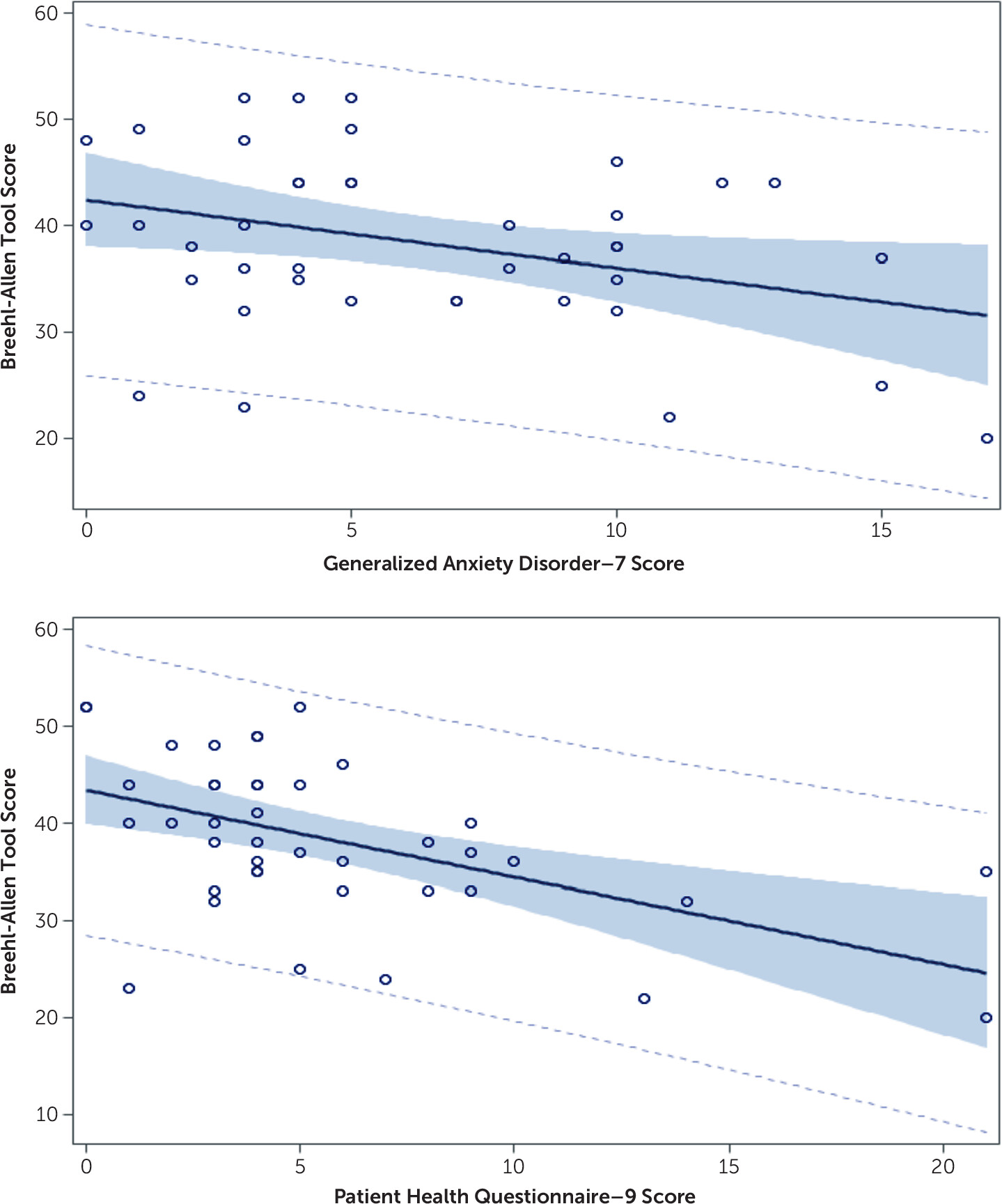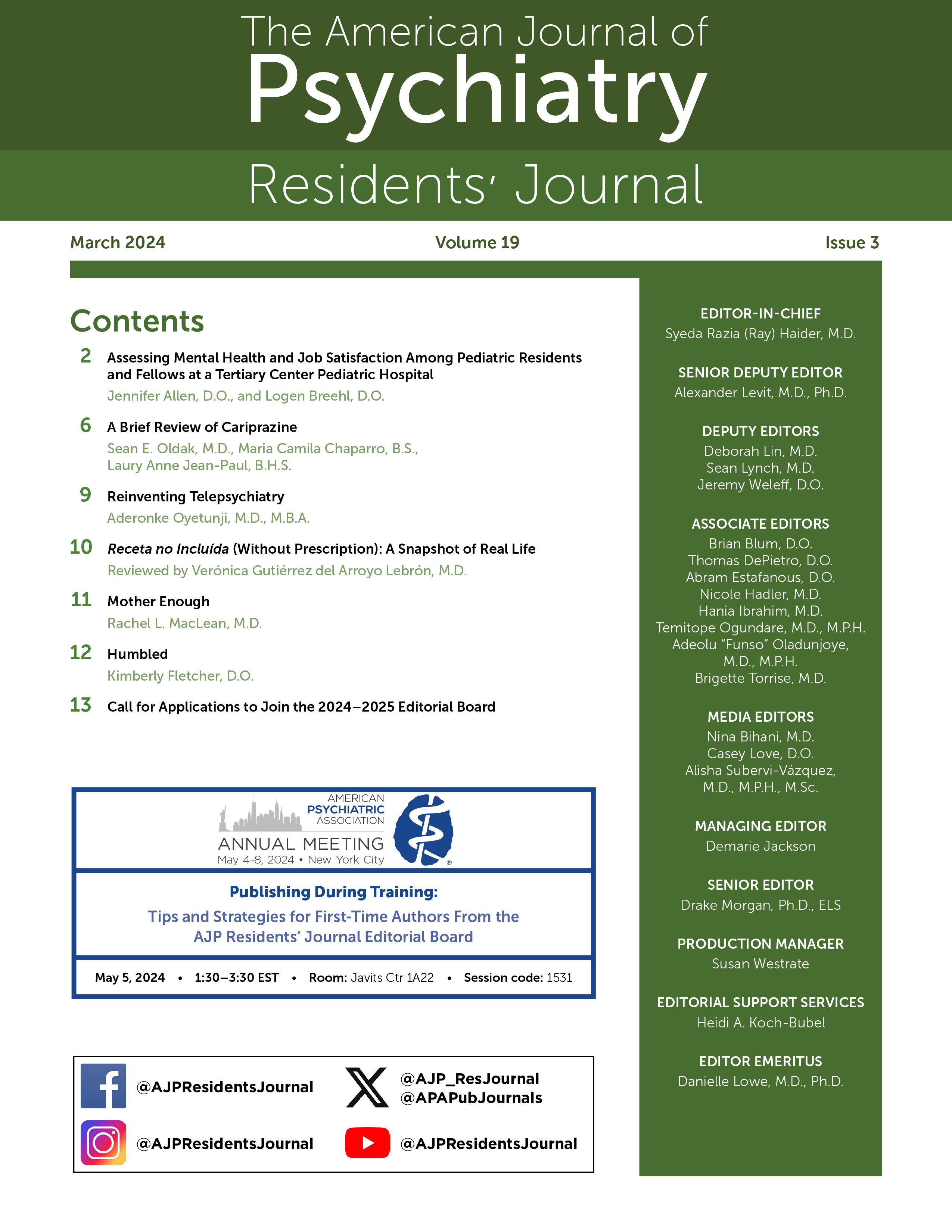In the past 20 years, the health of resident physicians has become a focus of the medical community. Resident health and wellness were first addressed formally by the Accreditation Council for Graduate Medical Education in 2011 with the decision to limit the number of first-year resident work hours in an effort to decrease medical errors, ensure patient safety, and improve resident mental health and well-being (
1). A nationwide cohort study examined resident physicians after this work-hour limitation was implemented and found an association with increased sleep duration as well as significantly lower risk of motor vehicle accidents, percutaneous injuries, and attentional failures (
1). This led to residency programs across the United States and in other countries implementing measures to decrease burnout and improve residency conditions (
2–
3).
There have been many studies examining rates of depression, anxiety, and burnout among resident physicians. However, there are few studies that specifically address burnout, depression, or lifestyle among pediatric trainees and correlate these variables with job or lifestyle satisfaction (
4–
8). The available literature focusing on rates of depression among physicians and residents shows that rates increase with each year of training (
4). A survey examining resident satisfaction found that 34% of residents reported life as stressful, and 17% rated their mental health as fair or poor (
2). Multiple causes of burnout have been proposed, such as long work hours, pressures caused by student debt, and frustrations of not having a personal life (
6,
9).
The definition of wellness and well-being within medicine has evolved and now incorporates the interaction between physical, social, and mental factors that allow for physician satisfaction (
10). One aspect of physician satisfaction is job satisfaction; however, there are few validated means to assess job satisfaction (
7). The Minnesota Satisfaction Questionnaire, among others, has been used to assess job satisfaction across all professions but is outdated and not specific to the job of a pediatric trainee (
11,
12). Additionally, most studies on satisfaction do not analyze specific aspects of an individual’s lifestyle and mental health factors or correlate them to job satisfaction (
7).
In the present study, we investigated mental and physical wellness among pediatric residents and fellows at a tertiary center pediatric hospital by using a novel job satisfaction questionnaire. We aimed to quantify physical health, mental health, and job satisfaction as well as to assess correlations between physical and mental health factors with job satisfaction.
Methods
Participants and Recruitment
This observational cross-sectional study utilized the Research Electronic Data Capture platform to collect data from 92 pediatric residents and fellows at a tertiary center pediatric hospital from October 2021 to January 2022 (
13,
14). Participants were recruited via e-mail at 4- to 6-week intervals for three time periods. E-mail addresses were obtained from the medical education office. A total of 58 questions, including those collecting demographic data, were included. Data from the survey were collected and recorded in accordance with Dillman’s validated survey methods (
15). All participants provided written informed consent after receiving a complete description of the study, and mental health resources were provided. The institutional review board of Akron Children’s Hospital approved this study.
Survey Instruments and Measures
The following five measures were utilized to assess the study population’s health status and job satisfaction: the Patient Health Questionnaire–9 (PHQ-9), the Generalized Anxiety Disorder 7-item (GAD-7) scale, a lifestyle questionnaire assessing diet and exercise, a job satisfaction questionnaire created by the authors (the Breehl-Allen tool), and an overall job satisfaction score (
16–
18). For further details on the survey distributed, see the
online supplement.
Possible scores on the GAD-7 range from 0 to 21, with higher scores indicating more severe anxiety symptoms, and scores on PHQ-9 can range from 0 to 27, with higher scores indicating more severe depressive symptoms. The lifestyle questionnaire (the diet and exercise score can range from 14 to 70, with higher scores indicating a healthier diet and more active lifestyle) included the original survey questions (
18); however, the examples were altered to match American culture. The Breehl-Allen tool was created utilizing the 13 distinct aspects of resident job satisfaction, referenced in a resident satisfaction study and questionnaire (
7,
11). This tool assessed the satisfaction of pediatric trainees with various aspects of their job. The survey questions were rated on a 5-point Likert scale, with a minimum score of 14 and a maximum score of 65 (higher scores indicate greater satisfaction). The overall job satisfaction question (“How satisfied are you overall with your job at Akron Children’s Hospital?”) was used as a single quantity to assess overall job satisfaction (scores can range from 0 to 5, with higher scores indicating greater job satisfaction) and served as data to internally assess the validity of the job satisfaction questionnaire created by the authors.
Statistical Analysis
The analysis included the calculation of distribution-based summary statistics. Pearson’s product-moment correlation coefficients were calculated for continuous and rank data representing depression, anxiety, lifestyle, and job satisfaction scores with the scores from the Breehl-Allen tool. Univariate linear regression was used to assess and quantify the magnitude of associations between all variables and scores from the Breehl-Allen tool. All analyses were conducted with SAS, version 9.4/14.2, and results were interpreted at a type-I error rate with statistical significance set at α=0.05.
Results
The survey had a 45% response rate (N=41 of 92). The mean age was 29.5 years, with women representing the majority (N=30 of 41, 73%). Most survey respondents were residents (N=32 of 41, 78%) from all levels of training (postgraduate year [PGY]-1: N=13, 32%; PGY-2: N=14, 34%; PGY-3: N=5, 12%; PGY-4: N=5, 12%; PGY-5: N=3, 7%; PGY-6: N=1, 2%). Demographic and clinical characteristics of the study participants are summarized in
Table 1. The mean PHQ-9 score was 5.6, corresponding to most participants falling below the threshold for depression (score <5 indicates no depression; 44% met the threshold for depression). The mean GAD-7 score was 6.4, indicating that most participants did not meet the criteria for generalized anxiety disorder (29% of participants met the diagnosis of anxiety disorder, with a score >10). The mean diet and exercise score was 38.3, with a minimum score of 27 and maximum score of 53. The mean score on the Breehl-Allen tool was 38.3, indicating satisfaction, with common themes of relationships, working hours, administrative duties, and recognition. The mean job satisfaction score was 3.7 on a 5-point scale, indicating that most participants were satisfied working at a tertiary pediatric facility (63% rated overall job satisfaction as “agree” or “strongly agree”).
Overall job satisfaction scores (r
s=0.7) and PHQ-9 scores (r
s=–0.5) were modestly correlated with scores from the Breehl-Allen tool (p<0.01 for each), and the GAD-7 score was also correlated with the Breehl-Allen tool score (r
s=–0.3, p=0.03). The lifestyle score was not significantly correlated with the Breehl-Allen tool score (p=0.60). The significant correlations with GAD-7 and PHQ-9 scores indicated that these scores explained a portion of the variance in job satisfaction (R
2=0.11 and 0.26, respectively) (
Figure 1).
Discussion
Previous studies examining pediatric trainee burnout or mental health disorders in this population have proposed various interventions; however, our study results provide evidence of a correlation between mental health and job satisfaction. These results provide further justification for movements and interventions to promote mental health and improve job satisfaction among residents and fellow physicians. In our survey, 44% of participants had potential diagnoses of depression, and approximately 30% had potential diagnoses of significant anxiety. Most participants scored average on measures of diet and exercise, most scored average on measures of job satisfaction, and most were more than satisfied with their job at a tertiary pediatric facility. Given these findings, we can see that mental health plays an influential role in the overall well-being of pediatric trainees, and we can work toward providing an environment supporting future health care professionals. Interventions proposed have included introducing program-level activities to relieve the stress of high-acuity rotations, scheduling weekends off in a considered manner, and training individuals to develop protective factors, such as adequate sleep and compassion (
6,
8).
This study was limited by a low response rate, which resulted in a small sample size. External factors, such as trainee work life, discontinued use of e-mail, or lack of incentive, could have contributed to a lower response rate. The low response rate could also be explained by nonresponse bias or volunteer bias, with some residents or fellows more likely to participate than others. However, the data can still be used to make inferences about the larger population and provide a path for further study and inquiry. The statistical power to detect effects, were they present, was lower than the traditionally desired 80%, and therefore the results of the inferential statistical analyses are limited in their validity, generalizability, and usefulness. Because this is only a sample of pediatric residents and fellows at a single tertiary pediatric hospital, the results may not be universally applicable. There may be differences in program environments affecting the views of trainees at different facilities. However, our study could be reproduced at other institutions to further support and expand on our results.
Conclusions
This study reveals that anxiety and depression symptoms correlate with job satisfaction among pediatric residents and fellows. The Breehl-Allen tool had a notable correlation with overall job satisfaction scores, which allows for future analyses of resident and fellow job satisfaction and possible future validation of the tool. Such analyses would require a larger sample size, which could confirm our results and would represent a starting point for providing support for and improving the pediatric training experience.
Key Points/Clinical Pearls

